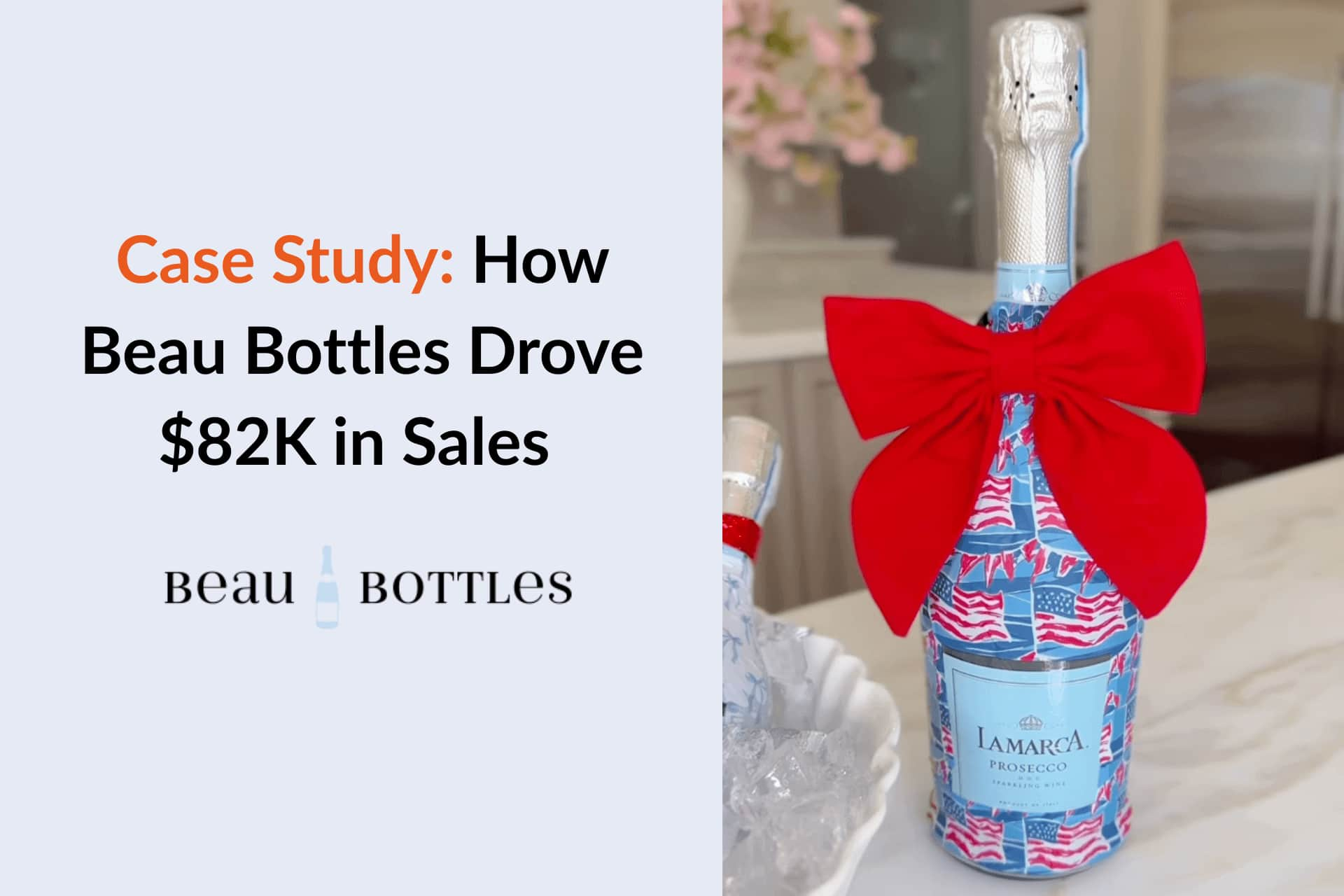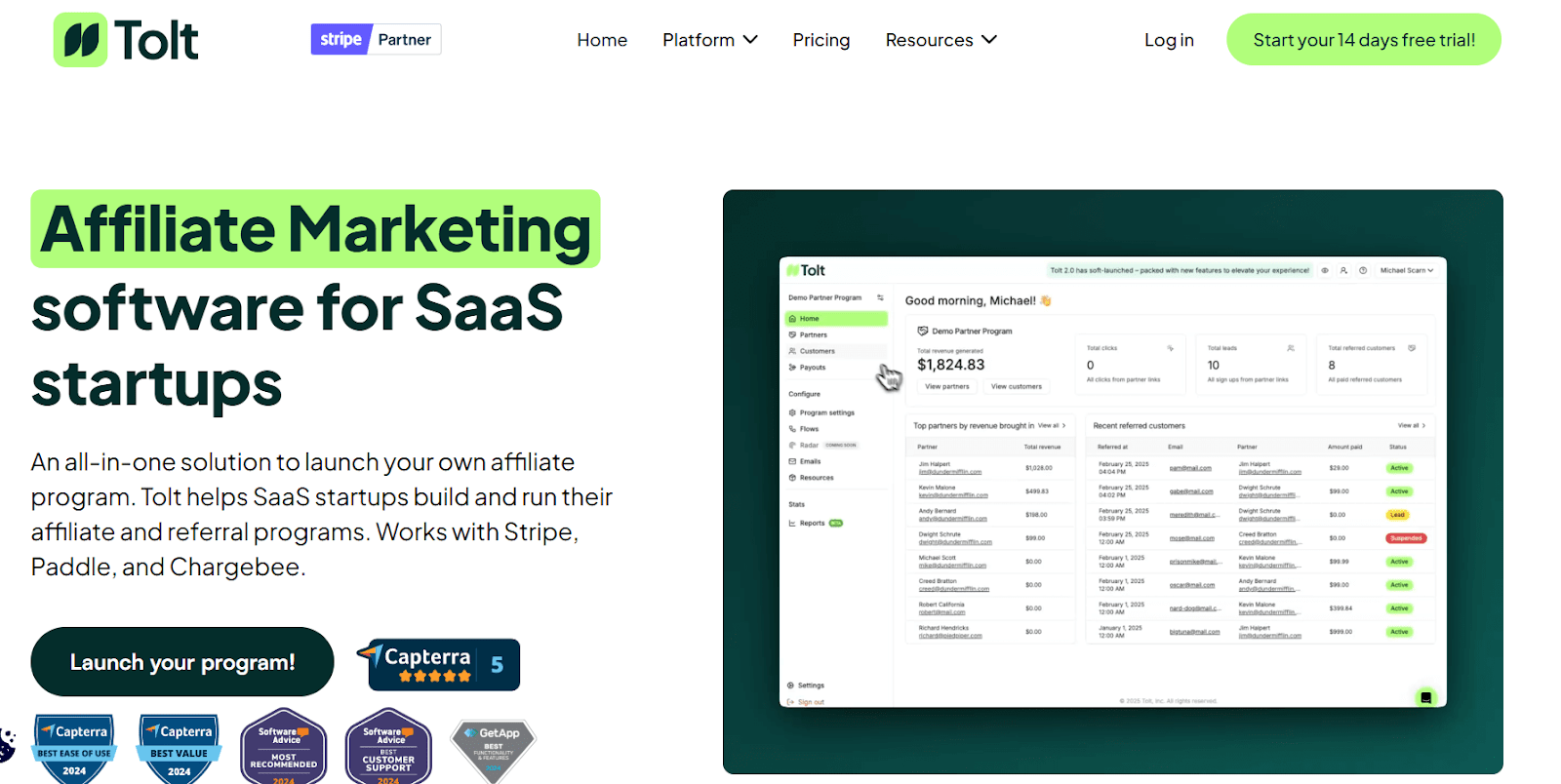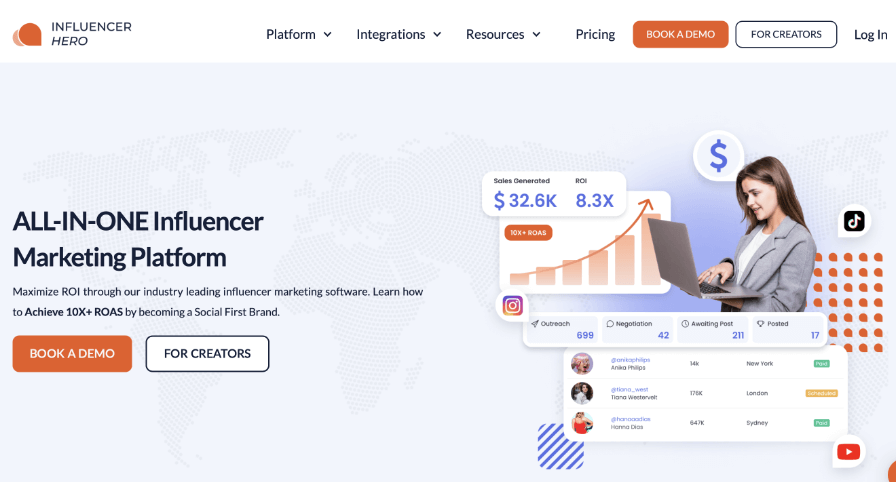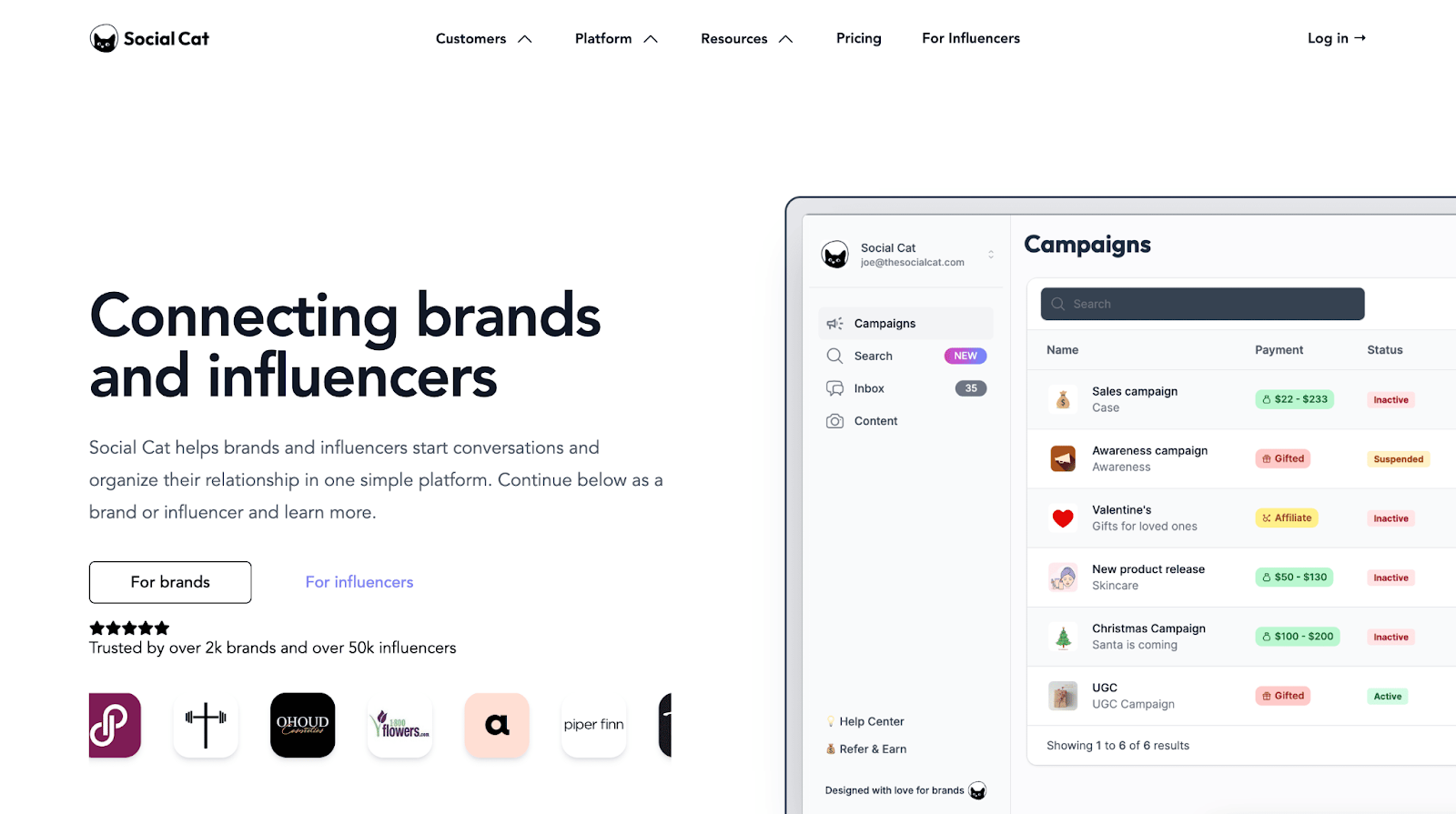





Tolt emerges as a specialized affiliate marketing platform designed to streamline the process of carrying out an affiliate program. Offering features like automated payouts, fraud protection, and seamless integrations with platforms such as Stripe, Paddle, and Chargebee, Tolt provides an all-in-one solution for managing affiliate and referral programs. However, while Tolt excels in affiliate program management, brands seeking a comprehensive influencer marketing solution might find its capabilities limited.
The influencer marketing landscape continues to expand, with a recent report from eMarketer estimating that U.S. influencer marketing spend will surpass $10 billion in 2025. This growth underscores the importance of selecting the right platform to effectively engage with audiences and drive brand success.
Top 10 Tolt Alternatives
While Tolt provides SaaS startups with an affordable, branded, and easy-to-integrate affiliate solution, it does have limitations—particularly for businesses looking for advanced analytics, affiliate discovery tools, or support beyond the SaaS ecosystem.
Tolt lacks the in-depth reporting and insights offered by more established platforms like PartnerStack. Users migrating from those tools often mention missing detailed dashboards and analytics. That said, the trade-off is significantly lower pricing, making it attractive for startups but less ideal for data-driven growth teams.
Currently, Tolt doesn’t provide an affiliate marketplace or discovery feature. This means brands must recruit affiliates themselves instead of browsing a built-in network. For some, this slows down scaling efforts, although users believe affiliate discovery may be added in the future.
Tolt is designed specifically for SaaS startups. While this makes it excellent for subscription-based software businesses, ecommerce or non-SaaS companies may find it less suitable compared to broader affiliate platforms that support multiple industries.
Although Pro and Enterprise users gain access to a dedicated Slack channel, there is limited public information about customer support quality and Tolt’s ability to scale with high-volume programs. This may raise concerns for brands planning rapid expansion.
To compare the different platforms, we focused on central criteria that all must meet:

Platform Coverage: Instagram, YouTube, TikTok. Brands can incorporate affiliates from other platforms in the higher plans tiers.
Best For: Early-stage and scaling SaaS businesses looking to quickly launch branded affiliate and referral programs without building infrastructure from scratch. Tolt is especially suited for founders who want automated payouts, branded affiliate portals, and seamless integration with their existing billing stack.
Pricing: Tolt offers the following pricing structures:
Review: 4.3/5.0 (Capterra)
Ease of Use (UX/UI): Tolt is designed with simplicity in mind for SaaS founders. Its branded affiliate portals make onboarding affiliates straightforward, and integrations with Stripe, Paddle, and Chargebee are fast to set up.
Customer Support: Pro and Enterprise customers receive access to dedicated Slack channels. Brands who join with lower tier plans can receive customer support through email.

Platform Coverage: Influencer Hero supports influencer marketing across Instagram, TikTok, YouTube, Facebook, Pinterest, Snapchat, X (Twitter), and Twitch.
Best For: Influencer Hero is best for fast-scaling DTC brands and eCommerce businesses on Shopify, WooCommerce, or custom setups looking to run high-volume influencer, affiliate, and UGC campaigns from a single dashboard.
Pricing: Influencer Hero offers flexible monthly plans:
Reviews: 5.0 / 5.0 on Capterra
Ease of use (UX/UI): The interface is designed for quick campaign setup, with process maps and workflows that streamline execution. Even new users can become comfortable quickly, reducing onboarding time.
Customer support: All plans include a personal account contact, with higher tiers offering priority channels, Slack support, and strategic guidance calls. This round the clock support offered by Influencer Hero is highlighted by brands and creators who partner with them, as it makes the overall experience better.
Tolt provides an all-in-one affiliate program solution tailored for SaaS startups, with pricing starting at $49/month, while Influencer Hero’s plans begin at $649/month and scale with creator volume. Influencer Hero stands out for multi-platform influencer management, enabling brands to run campaigns across Instagram, TikTok, YouTube, and more from a single dashboard.
Both platforms offer robust automation, but Tolt focuses on affiliate payouts, branded portals, and Stripe/Paddle/Chargebee integration, whereas Influencer Hero provides advanced creator search, automated outreach workflows, and eCommerce syncing. For brands aiming to combine high-volume influencer campaigns with affiliate tracking, Influencer Hero’s comprehensive multi-platform approach offers more flexibility and depth.
Influencer Hero justifies higher pricing with multi-channel influencer capabilities, live analytics, high-touch account support, and still providing affiliate payments management. This makes Influencer Hero a strong choice for DTC brands and eCommerce businesses looking to scale quickly and efficiently.

Platform coverage: Instagram, YouTube and TikTok. Limited functionality for influencers from Snapchat and X.
Pricing: Modash pricing starts at $199 per month. They also offer a medium tier plan fixed at a $499 rate. The enterprise level plan has custom pricing.
Reviews: 4.9/5.0 (Capterra)
Ease of Use (UX/UI): Optimized for rapid influencer discovery with smooth-loading filters and a simple interface. Users can begin exploring campaigns almost immediately without formal onboarding.
Customer Support: Offers email support for all users, with live chat and priority response for higher-tier plans. Tutorials and a growing knowledge base help users onboard efficiently.
Tolt’s pricing starts at $49/month for startups, whereas Modash begins at $199/month with a higher tier at $499, plus enterprise pricing. Tolt emphasizes affiliate program management with auto payouts and branded portals, while Modash focuses on influencer discovery and analytics across Instagram, TikTok, and YouTube.
Both platforms offer tracking and automation, but Modash provides global creator access, audience authenticity checks, and live content monitoring, whereas Tolt handles payouts, commission flows, and integration with Stripe/Paddle/Chargebee. This makes Tolt ideal for SaaS affiliate programs, and Modash better suited for influencer discovery and campaign management.
For budget-conscious teams, Tolt offers lower starting costs and simplified affiliate workflows, while Modash requires higher monthly investment but delivers more in-depth influencer data and segmentation tools. The choice depends on whether brands prioritize affiliate program efficiency or influencer program insights.

Platform Coverage: Instagram, TikTok, and YouTube.
Best For: Social media teams needing advanced scheduling, performance measurement, and listening capabilities integrated with influencer collaboration.
Pricing: Sprout Social starts at $1,599 per user/month, $600/month for additional users; billed monthly or annually with a required 12-month contract.
Reviews: 4.5/5.0 (Capterra)
Ease of Use (UX/UI): Clean and intuitive dashboard centralizes publishing, engagement, and analytics across platforms. Teams can navigate scheduling and reporting without significant onboarding.
Customer Support: Offers email, chat, and phone assistance; higher-tier plans get a dedicated success manager. Support helps with platform adoption and campaign troubleshooting.
Tolt offers tiered pricing starting at $49/month, compared to Sprout Social’s $1,599/month per user, showing the difference between cost-efficient affiliate and influencer tools versus enterprise-level social management platforms. Tolt emphasizes affiliate program automation, and simple campaign tracking, while Sprout Social focuses on social media scheduling, analytics, and team collaboration across multiple networks.
Both platforms allow performance tracking, but Sprout Social provides advanced analytics dashboards and unified inboxes, whereas Tolt streamlines influencer communications, content approvals, and affiliate payouts. Brands looking for social media operations might prefer Sprout Social, while Tolt suits teams prioritizing influencer campaigns and affiliate workflows.
For startups or mid-sized DTC brands, Tolt offers accessibility and flexibility at a lower cost, whereas Sprout Social’s higher price reflects its enterprise-grade social tools and dedicated support. Decision-makers should weigh budget against the depth of social media versus influencer program management when choosing between the two.

Platform coverage: Upfluence covers Instagram, TikTok, YouTube, X, Twitch, Pinterest, and WordPress blogs.
Pricing:
Reviews: 4.6/5.0 (G2)
Best For: E-commerce brands and agencies looking to scale YouTube influencer outreach and track ROI.
Ease of Use (UX/UI): Built for full-scale influencer marketing with a slightly steeper learning curve. The interface is comprehensive, ideal for experienced teams handling large campaigns.
Customer Support: Provides onboarding sessions, dedicated account managers for higher-tier plans, and responsive live chat/email support.

Platform coverage: Captiv8 covers Instagram, TikTok, Facebook, YouTube, X (formerly Twitter) and Twitch.
Pricing: $25.000 Annually (Annual commitment needed). Plus a $3.000 onboarding fee.
Reviews: 4.5/5.0 (G2)
Best for: Brands and agencies running large-scale influencer campaigns in platforms like Instagram, TikTok and YouTube.
Ease of Use (UX/UI): Comprehensive platform with robust tools for seasoned marketers. First-time users may require time to navigate and understand all features fully.
Customer Support: Offers personalized onboarding, campaign guidance, and dedicated account managers. Some users report slower response times for urgent queries or billing concerns.
Tolt offers tiered pricing starting at $49/month, compared to Captiv8’s $25,000/year plus $3,000 onboarding, reflecting a difference between SaaS affiliate tools and enterprise influencer management. Tolt focuses on affiliate program automation, branded portals, and Stripe/Paddle/Chargebee integration, whereas Captiv8 provides large-scale influencer campaigns with custom dashboards and team collaboration spaces.
Both platforms help track performance, but Captiv8 emphasizes advanced analytics, secure reporting, and team workflow management, while Tolt streamlines payouts, commission flows, and program setup for startups. This makes Tolt suitable for small SaaS brands and Captiv8 more appropriate for enterprise teams managing multi-platform influencer campaigns.
For cost-sensitive startups, Tolt offers accessibility and flexibility, whereas Captiv8’s pricing reflects its comprehensive enterprise-grade features and high-touch support. Brands must weigh budget against scale, as Captiv8 delivers more in-depth influencer management while Tolt excels in cost-efficient affiliate program automation.

Platform Coverage: CreatorIQ supports Instagram, TikTok, YouTube, Facebook, Pinterest, Twitch, and X (Twitter).
Pricing: CreatorIQ pricing is divided into 4 tiers:
An optional “Creator Connect” feature available for an additional $15,000 per yea
Reviews: 4.6/5.0 (G2)
Best For: Large-scale brands that require robust data controls, customizable workflows, and in-depth influencer analytics across international markets.
Ease of Use (UX/UI): Clean interface designed for team collaboration across campaigns. Workflow efficiency supports large-scale, multi-market campaigns.
Customer Support: Expert onboarding, dedicated account managers, and ongoing strategy guidance. Support ensures campaigns are optimized and meet KPIs.
Tolt offers plans starting at $49/month, compared to CreatorIQ’s enterprise-level pricing beginning at $35,000/year, highlighting Tolt’s focus on smaller teams and cost-effective campaign management. While Tolt streamlines affiliate programs, influencer outreach, and commission tracking, CreatorIQ provides enterprise features such as global payouts, compliance controls, and highly detailed influencer analytics.
Both platforms allow influencer discovery and workflow automation, but CreatorIQ is built for multinational campaigns with complex reporting needs, whereas Tolt prioritizes simplicity, rapid setup, and affiliate program efficiency. Brands that need scalable enterprise-level data management may prefer CreatorIQ, while Tolt is ideal for leaner teams looking for practical campaign tools.
Tolt is better suited for small SaaS or DTC brands requiring a low-cost, easy-to-deploy solution, while CreatorIQ’s pricing and features reflect its suitability for large brands managing global influencer networks. Choosing between them depends on whether the priority is budget-friendly influencer management or extensive enterprise-grade analytics and compliance.

Platform Coverage: HypeAuditor supports Instagram, TikTok, YouTube, Twitch, X (Twitter), and Snapchat.
Pricing: Flexible usage-based pricing, with Business plans starting at around $10,000/year and Enterprise reaching up to $60,000/year.
Reviews: 4.6/5.0 (G2)
Best For: Teams that prioritize data accuracy, detecting fraudulent activity, and benchmarking competitors across various influencer platforms.
Ease of Use (UX/UI): Modern interface designed for marketing professionals. Advanced tools require some training for full utilization.
Customer Support: Provides onboarding, live chat, email assistance, and a comprehensive knowledge base. Support ensures teams can quickly leverage insights for campaigns.
Tolt starts at $49/month, whereas HypeAuditor offers usage-based plans beginning around $10,000/year, reflecting the difference between accessible affiliate-focused tools and premium influencer analytics platforms. Tolt focuses on affiliate program automation, commission flows, and creator outreach, while HypeAuditor provides AI-driven influencer vetting, fraud detection, and audience benchmarking across multiple networks.
Both tools help evaluate influencer performance, but HypeAuditor emphasizes authenticity verification, market monitoring, and in-depth demographic insights, whereas Tolt prioritizes streamlined campaign execution, commission tracking, and easy influencer management. Brands seeking detailed fraud detection may lean toward HypeAuditor, while cost-sensitive teams may find Tolt more practical.
For smaller brands or startups, Tolt delivers a flexible and affordable solution, whereas HypeAuditor is designed for teams with substantial budgets who need sophisticated analytics and influencer intelligence. Ultimately, the choice depends on whether advanced reporting or efficient program execution is the top priority.

Platform Coverage: Instagram, TikTok, YouTube, X (formerly Twitter), Twitch, and Snapchat.
Pricing: GRIN’s yearly pricing starts at $25.000, with monthly payments available at $2.085/month. No discounts for upfront payments.
Best For: Best suited for DTC brands looking to centralize influencer relationship management in one streamlined system.
Reviews: 4.5/5.0 (G2)
Ease of Use (UX/UI): Intuitive and simple for campaign management. May slow down with large influencer sets or batch processing.
Customer Support: Offers onboarding, email, and chat support; premium customers receive dedicated strategists. Support quality may vary.
Tolt offers tiered pricing starting at $49/month, compared to GRIN’s $25,000/year or $2,085/month, highlighting the contrast between accessible SaaS affiliate solutions and full-service influencer relationship management. Tolt focuses on affiliate program automation, branded portals, and quick influencer setup, while GRIN provides centralized campaign management, CRM integration, and deep eCommerce tracking.
Both platforms track performance, but GRIN emphasizes advanced reporting, team coordination, and detailed influencer analytics, whereas Tolt streamlines payouts, commission flows, and influencer contracts management. Brands looking for holistic influencer relationship management may prefer GRIN, while those seeking affordable, efficient program management will benefit from Tolt.
Tolt is more suitable for small to mid-sized DTC or SaaS brands, offering lower costs and simplicity, whereas GRIN’s pricing reflects its enterprise-grade features and high-touch support. Choosing between the two depends on whether the priority is cost-efficient affiliate management or comprehensive influencer program oversight.

Platform Coverage: Instagram, TikTok, YouTube, Twitter, and Facebook.
Pricing:
Best for: Small businesses and emerging brands looking for a budget-friendly, intuitive influencer marketing solution with built-in CRM and AI-powered influencer discovery. Well-suited for lean teams expanding their influencer marketing without enterprise complexity.
Reviews: 4.6/5.0 (G2)
Ease of Use (UX/UI): Offers a clean and intuitive interface built for rapid campaign setup, though free-tier restrictions may limit high-volume users.
Customer Support: Includes onboarding support and email help, with more comprehensive guidance available only on higher tiers.
Wednesday.App offers tiered pricing starting with a free plan and paid tiers beginning at $79/month, compared to Tolt’s $49/month starter plan, reflecting a difference between AI-powered influencer marketing tools and SaaS affiliate program automation.
Wednesday.App emphasizes AI-assisted influencer search, integrated messaging, and team collaboration, whereas Tolt focuses on automating affiliate payouts, commission flows, and branded portals. Both platforms facilitate campaign management, but Wednesday.App provides a broader set of CRM and outreach features for small teams.
For budget-conscious startups, Tolt offers affordability and simplicity, whereas Wednesday.App’s free and paid tiers provide more robust influencer discovery and team collaboration capabilities. Brands must weigh their need for AI-driven influencer management against Tolt’s focus on efficient affiliate program automation.

Platform Coverage: Instagram and TikTok, with a focus on micro and nano influencers for visually-driven campaigns.
Best for: Small to medium-sized brands launching or scaling influencer marketing with straightforward tools without enterprise complexity.
Pricing:
Review: 4.3/5.0 (Trustpilot)
Ease of Use (UX/UI): Beginner-friendly interface designed for straightforward campaign management and influencer collaboration.
Customer Support: Email support available for all plans, with priority assistance for Pro subscribers.
SocialCat starts at $99/month for its Essentials plan, compared to Tolt’s $49/month starter, highlighting the difference between beginner-friendly influencer platforms and affiliate marketing software for startups. SocialCat focuses on Instagram and TikTok micro and nano influencers with manual campaign management, while Tolt automates affiliate commissions, branded portals, and payout flows.
Both platforms support small to medium-sized brands, but SocialCat emphasizes content rights, influencer applications, and campaign tracking, whereas Tolt streamlines program setup and ongoing affiliate operations. SocialCat is more suitable for hands-on influencer management, while Tolt allows lean teams to run affiliate programs with minimal administrative effort.
For cost-sensitive brands, Tolt delivers a more accessible starting point, while SocialCat provides additional features for managing influencer collaborations and content rights. Companies must decide whether they need dedicated influencer tools or scalable affiliate program automation for growth.
Tolt stands out as a streamlined affiliate and influencer marketing platform designed for startups and small businesses seeking simple, automated management of affiliate programs. Its strengths lie in automating commission flows, managing branded portals, and integrating seamlessly with payment processors like Stripe, Paddle, and Chargebee, making it ideal for teams looking to scale affiliate programs without heavy manual work.
For brands that also need influencer discovery, campaign collaboration, or advanced CRM features, platforms like Influencer Hero offer broader tools and multi-platform support. Tolt’s focus on cost-effective, accessible automation makes it particularly well-suited for startups and lean teams prioritizing efficiency and predictable budgeting over enterprise-level campaign management.

Tolt is ideal for small to mid-sized SaaS companies and startups looking to automate affiliate programs and manage commission flows efficiently. Brands focused on subscription-based products or online sales can benefit from its Stripe, Paddle, and Chargebee integrations.
The platform is designed for simplicity, with a clean interface and easy setup for affiliate tracking and branded portals. However, teams looking for multi-platform influencer campaign management may find its features more limited compared to Influencer Hero.
Influencer Hero provides a wider array of capabilities, including multi-platform influencer discovery, built-in CRM tools, and automated campaign workflows. Its scalable pricing and deep ecommerce integrations make it a better choice for brands expanding beyond affiliate programs into full influencer marketing campaigns.
Certain Tolt alternatives, like Influencer Hero and Aspire, offer features that integrate with e-commerce platforms for influencer gifting and affiliate marketing. This integration allows for seamless product dispatch to influencers and tracking of sales generated through affiliate links, enhancing the efficiency and effectiveness of influencer marketing campaigns.
Yes, Tolt is already cost-effective for startups, but platforms like Wednesday.App and SocialCat offer entry-level plans with influencer discovery and basic outreach tools. While they provide affordability, Influencer Hero balances cost with more advanced features and multi-platform reach.



Schedule a Demo with one of our media experts below.